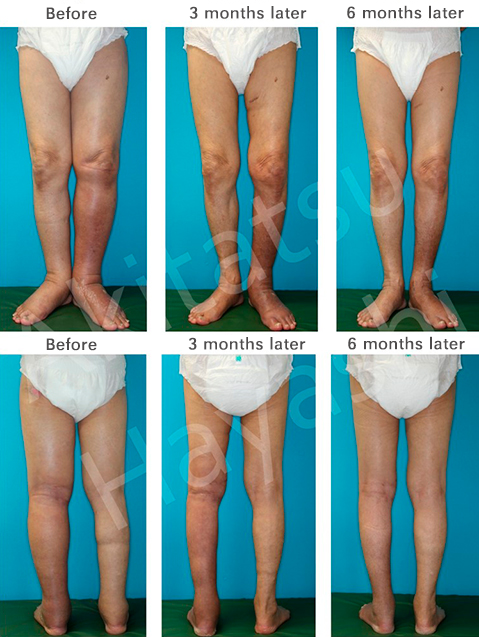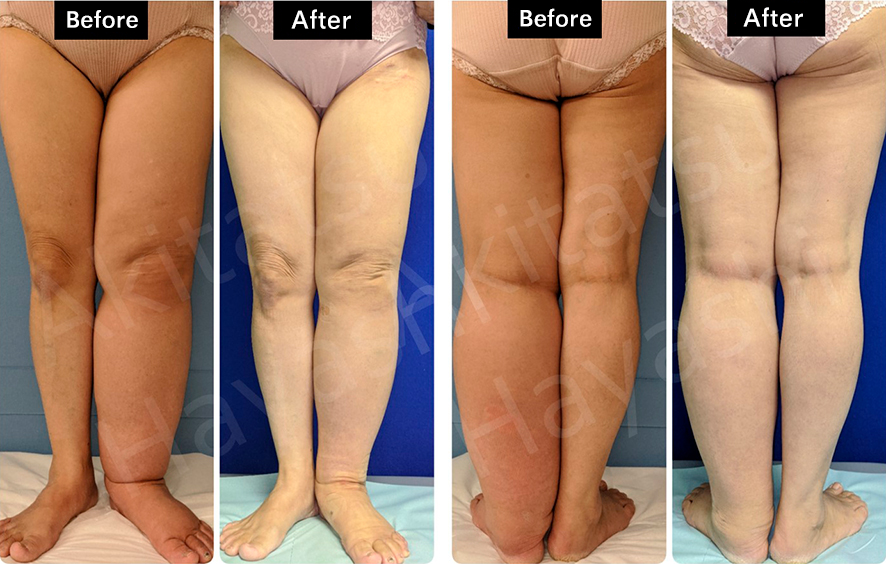Example Cases
To deepen your understanding of lymphedema, we will first talk about blood vessels and lymph vessels, then the difference between bloating, edema, and swelling.
(1) Lymphedema of the Upper Limbs After Breast Cancer Surgery (by a woman in her 70s)
Thirty-five years ago, she underwent partial mastectomy/pectoralis resection, axillary lymph node dissection, and radiotherapy for the cancer on her left breast. Since three years ago, lymphedema has begun to appear on her left upper limb, and while she has undergone conservative treatment, the symptoms gradually worsened. In the past few years, she has had frequent episodes of cellulitis (fever of about 40 degrees Celsius), making it very difficult for her to lead a social life and to continue conservative treatment. After her surgery at our center, her edema improved and her cellulitis almost disappeared. On top of that, her cellulitis has also almost disappeared.

(1) Lymphedema of the Upper Limbs After Breast Cancer Surgery (by a woman in her 50s)
Four years ago, she underwent partial mastectomy, axillary lymph node dissection, and chemotherapy for the cancer on her left breast. Since three years ago, lymphedema has begun to appear on her left upper limb, and while she has undergone conservative treatment, the symptoms gradually worsened. She suffered from repeated cellulitis and difficulty in grasping with her hands and doing housework. As she showed strong resistance to conservative treatment, we performed lymphovenous anastomosis at our center. While she continues to do compression theory, her edema improved, cellulitis almost disappeared, and she was able to do more housework than before after her surgery,

(3) Lymphedema of the Upper Limbs After Prostate Cancer Surgery (by a male in his 60s)
Six years ago, he underwent robot-assisted total prostatectomy and extended pelvic lymph node dissection for prostate cancer. After the treatment, lymphedema appeared in his left lower limb and gradually worsened despite conservative treatment. About 6 months later, lymphedema in the right lower limb and pubic region also appeared. For the past few years, he has experienced cellulitis (fever of about 39 degrees Celsius) two to three times a year, making it very difficult to even perform compression therapy and to live a social life. At our center, we performed a lymphovenous anastomosis under local anesthesia in both lower limbs, causing the cellulitis to no longer occur, the edema to reduce, and the patient now living in stockings with very low pressure.

(4) Lymphedema of the Upper Limbs After Cervical Cancer Surgery (by a woman in her 50s)
Twelve years ago, she underwent a semi-extensive total hysterectomy and pelvic lymph node dissection for cervical cancer. Two years later, lymphedema of the left lower extremity began to appear, and while conservative treatment was performed, the symptoms gradually worsened with cellulitis (fever of about 39-40℃) occurring frequently. As it was very difficult to perform compression therapy to her with restrictions in daily life gradually appearing, the patient underwent intensive decompression therapy at our center, and her edema was slightly reduced. In addition, we performed lymphatic vein anastomosis and thigh liposuction under general anesthesia, which resulted in further improvement of edema and a much better quality of life.


Akitatsu Hayashi
Kameda Medical Center / Kameda Kyobashi Clinic
Director of Lymphedema Center
Dr. Hayashi presented state-of-the-art lymphatic vessel imaging technology using Ultrasound and Optical
Coherence Tomography (OCT) for the first time in the world. He focuses on the spread of more efficient and
effective lymphedema surgery using the technology.Check profile more



